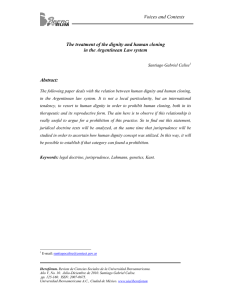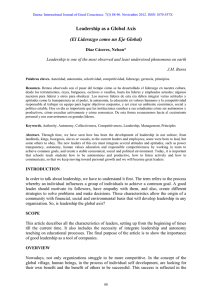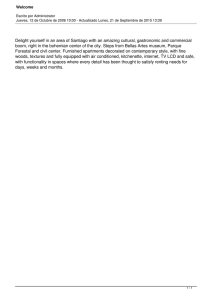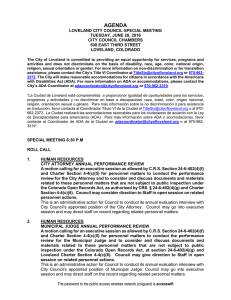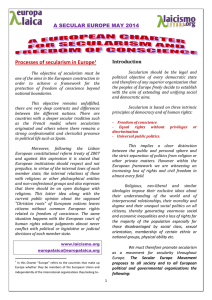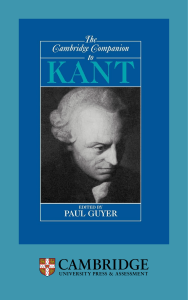The Four Values of the Charter of Fundamental Rights of the
Anuncio
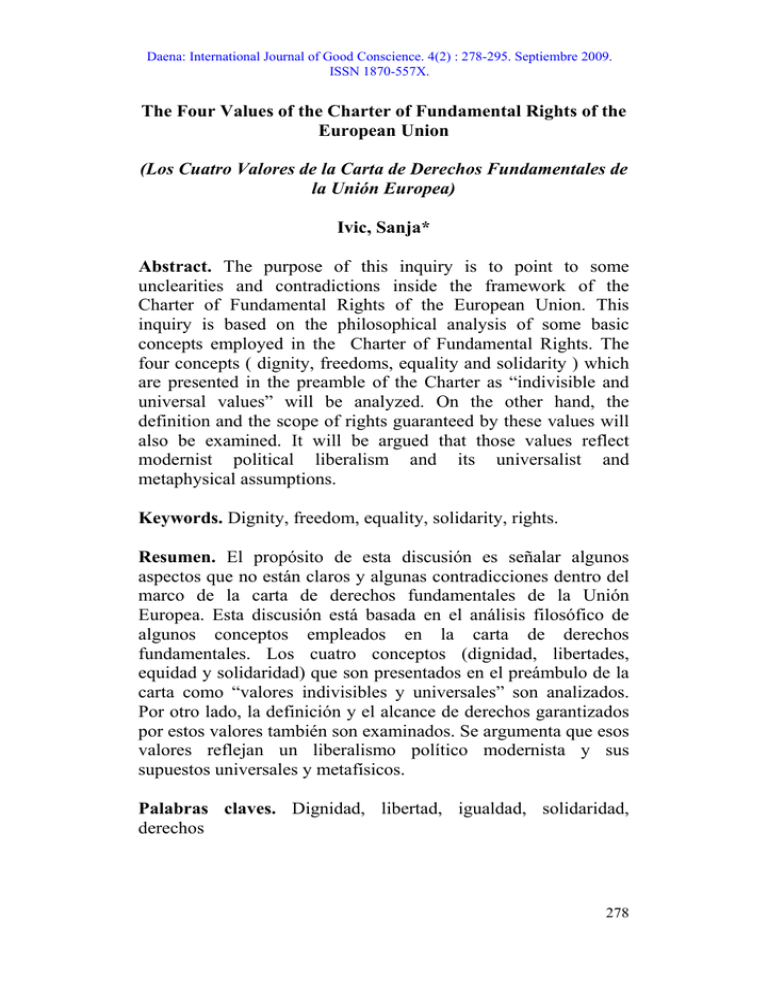
Daena: International Journal of Good Conscience. 4(2) : 278-295. Septiembre 2009. ISSN 1870-557X. The Four Values of the Charter of Fundamental Rights of the European Union (Los Cuatro Valores de la Carta de Derechos Fundamentales de la Unión Europea) Ivic, Sanja* Abstract. The purpose of this inquiry is to point to some unclearities and contradictions inside the framework of the Charter of Fundamental Rights of the European Union. This inquiry is based on the philosophical analysis of some basic concepts employed in the Charter of Fundamental Rights. The four concepts ( dignity, freedoms, equality and solidarity ) which are presented in the preamble of the Charter as “indivisible and universal values” will be analyzed. On the other hand, the definition and the scope of rights guaranteed by these values will also be examined. It will be argued that those values reflect modernist political liberalism and its universalist and metaphysical assumptions. Keywords. Dignity, freedom, equality, solidarity, rights. Resumen. El propósito de esta discusión es señalar algunos aspectos que no están claros y algunas contradicciones dentro del marco de la carta de derechos fundamentales de la Unión Europea. Esta discusión está basada en el análisis filosófico de algunos conceptos empleados en la carta de derechos fundamentales. Los cuatro conceptos (dignidad, libertades, equidad y solidaridad) que son presentados en el preámbulo de la carta como “valores indivisibles y universales” son analizados. Por otro lado, la definición y el alcance de derechos garantizados por estos valores también son examinados. Se argumenta que esos valores reflejan un liberalismo político modernista y sus supuestos universales y metafísicos. Palabras claves. Dignidad, libertad, igualdad, solidaridad, derechos 278 Daena: International Journal of Good Conscience. 4(2) : 278-295. Septiembre 2009. ISSN 1870-557X. Introduction The Charter of Fundamental Rights 1 of the European Union is integral part of European Constitution. Therefore, it has a constitutional status, not only legal. According to the Article 51 of the Charter: “The provisions of this Charter are addressed to the institutions and bodies of the Union with due regard for the principle of subsidiarity and to the Member States only when they are implementing Union law.” European Court of Justice is entitled to defend the rights defined by the Charter of Fundamental Rights. Although the Charter embraces a broader content of rights than European Convention for the Protection of Human Rights 2 and Fundamental Freedoms and includes a new set of rights such as: the rights of the elderly ( Article 25 ), integration of persons with disabilities ( Article 26 ), prohibition of child labor and protection of young people at work ( Article 32 ), the right to good administration ( Article 41 ), etc. it still can be argued that it does not offer a better theoretical framework of rights and that these rights are well defined. European Charter of Fundamental Rights provides “the accession by the European Union to the European Convention on Human Rights entailing as a corollary, with the necessary institutional modifications, acceptance by the European Union of the jurisdiction of the Strasbourg Court.” 3 The Charter of rights which expresses EU’s notion of citizenship, goals and values is necessary. However, the problem arises when we try to exactly define those concepts. 1. Metaphysical Presuppositions of the Charter Fundamental Rights of the European Union of The preamble of the Charter of Fundamental Rights states: “The peoples of Europe, in creating an ever closer union among them, are resolved to share a peaceful future based on common values.” 1 It was launched by the Council of Ministers, European Parliament and European Commission on December, 8 in 2000. 2 European Convention for the Protection of Human Rights and Fundamental Freedoms mostly includes civil and political rights. 3 Jacobs, F.G, “The European Convention on Human Rights, the EU Charter of Fundamental Rights and the European Court of Justice: The Impact of European Union Accesion to the European Convention on Human Rights“, www.eclnet/elements/conferences/book_berlin/jacobs.pdf 279 Daena: International Journal of Good Conscience. 4(2) : 278-295. Septiembre 2009. ISSN 1870-557X. First of all, the question can be asked how the term “peaceful future” is defined. European Union is the project of peace which arose after the catastrophes of the World War II. The leading European countries were interested to provide the continent of Europe stability and permanent peace. According to Glasisu and Caldor, European Union should create its own military force. 4 According to their opinion, European Union as a “peace project” should not only be founded on Kant’s principles defined in his Perpetual Peace. 5 However, the idea of European Union as a project of peace can be questioned if it embraces a military force. 6 The other problem is represented by the term “common values” employed in the preamble of the Charter of Fundamental Rights. At first, this term seems vague and it is not clear whether it refers to cultural, ethnic, political or civic values. However, in the continuing text of the preamble it is stated that “the Union is founded on indivisible, universal values of human dignity, freedom, equality and solidarity; it is based on the principles of 4 Glasisu, M & Kaldor, M, “Individuals First: A Human Security Strategy for the European Union“, IPG 1/2005 5 In his Perpetual Peace: A Philosophical Sketch, Kant introduces “preliminary articles“ which represent the conditions which need to be satisfied in order to establish a perpetual peace between the states. On the other hand, Kant introduces “definitive articles“ on which the peace between the states should be founded. Kant’s preliminary articles are: 1. “No Treaty of peace shall be held valid in which there is tacitly received matter for a future war“; 2. “No independent states large or small shall come under the dominion of another state by inheritance, exchange, purchase or donation“; 3. “Standing armies ( miles perpetuus ) shall in time be totally abolished“; 4. “National debts shall not be contracted with a view to the external friction of states“; 5. “No state shall by force interfere with the constitution or government of another state“; 6. “No state shall, during the war, permit such acts of hostility which would make mutual confidence in the subsequent peace impossible: such are the employment of assassins ( percussores ), poisoners ( venefici ), breach of capitualation and incitement to treason ( perduellio ) in the opposing state.“ Kant’s definitive articles for the perpetual peace among the states are: 1. “The civil constitution of every state should be republican“; 2.“The law of nations shall be founded on a federation of free states“; 3. “The law of world citizenship shall be limited to the conditions of universal hospitality.“ ( Kant, I, Perpetual Peace: The Philosophical Sketch, 1795, http://www.mtholyoke.edu/acad/intrel/kant/kant1.htm 6 Nakarada, R, “European Union as a Peace Project”, Socioloski pregled, No. 4, 2006, p. 554 280 Daena: International Journal of Good Conscience. 4(2) : 278-295. Septiembre 2009. ISSN 1870-557X. democracy and the rule of law.” It can be asked in which sense those values are universal. Does the reading of those concepts require the point of view established by the philosophers of the Enlightenment who argued that these values represent absolute truth based on reason? That is why this form of liberalism is labeled by Bridges as “metaphysical”. 7 Bridges emphasizes the distinction between the modernist metaphysical liberalism which results from the Enlightenment philosophy, on the one hand, and the political or rhetorical liberalism which is represented by Rawls’s political theory, on the other hand. He argues that political liberalism rejects the universalist and essentialist assumptions and emphasizes cultural particularism. 8 Rawls also leaves the room for various interpretations of human rights. He makes a distinction between the norms of rights and justification of these norms. 9 According to Bridges, modernist metaphysical liberalism as a whole can be described as a “comprehensive doctrine” 10 , defined by Rawls. Rawls’s conception of political liberalism is neutral and does not include terms such as “common values”, “moral heritage”, “inherent”, and so forth. According the text of the preamble of the Charter of Fundamental Rights, it can be argued that it follows modernist metaphysical assumptions. It emphasizes European “spiritual and moral heritage”. Indeed, the proponents of modernist metaphysical liberalism argue that this form of liberalism reflects the political morality, which is universal and essential. 7 Bridges, Thomas, The Culture of Citizenship: Inventing Postmodern Civic Culture, Chapter II, State University of New York Press,1994, http://www.cvrp.org.book/Series01/I-26/contents.htm 8 Ibid. 9 Charles Taylor argues that the main discrepancies between the human rights perceived from the perspective of different cultures, are not based on the legal norms, but on different interptetations of these norms. 10 The comprehensive doctrine includes different religious, philosophical and other points of view and different conceptions of the good life. 281 Daena: International Journal of Good Conscience. 4(2) : 278-295. Septiembre 2009. ISSN 1870-557X. The Charter of Fundamental Rights is divided in six chapters: 1.“Dignity”; 2.“Freedoms”; 3.“Equality”, 4.“Solidarity”, 5.“Citizen’s Rights” and 6.“Justice”. According to Menéndez, the terminology of the Charter is confusing and it is based on “a fourfold distinction between ‘values’, ‘principles’ ‘freedoms’ and ‘rights’ but the legal meaning of such a categorization is not clearly stated or even consistently followed through the text, not even in the preamble. (…) Equality is characterized as value, while the rule of law is said to be a principle, something far from fitting into the standard use in common constitutional traditions.” 11 The principles introduced in the Charter of Fundamental Rights are the principles of democracy and the rule of law. It can be argued that in the Charter the term “principle” is broader in scope than “value”. For example, the principle of democracy embraces four values defined by the Charter: dignity, freedoms, equality and solidarity. 2. Dignity Dignity is defined as a basic characteristic which should be attributed to every human being by preamble and Article 1 of Universal Declaration of Human Rights. In the preamble of the Declaration of the Rights of Man and Citizen dignity is described as “inherent” to every human being. However, in the Article 1 of the Charter of Fundamental Rights, those universalist and essentialist assumptions are not employed. 12 On the other hand, it is still not clear what the human dignity is. This concept was differently defined in the history of philosophy. Various philosophical definitions of dignity are based on different conceptions of human nature and personality. The philosophers of the Enlightenment perceive human dignity as inherent to every human being, i.e. human nature which is defined by reason. Their 11 Menéndez, A. J, “The Sinews of Peace: Rights to Solidarity in the Charter of Fundamental Rights of the European Union“, Ratio Juris, Vol. 16, No. 3, September 2003, p. 380-381 12 Article 1 of the Charter of Fundamental Rights states: “Human dignity is inviolable. It must be respected and protected.“ 282 Daena: International Journal of Good Conscience. 4(2) : 278-295. Septiembre 2009. ISSN 1870-557X. conception of the self is derived from the totalizing character of the reason. 13 It is based on “totalizing metaphysical theories about the nature of things.” 14 Consequently, this conception of human dignity and personality can be characterized as “metaphysical”. In his Groundwork, Kant equates dignity and humanity. Kant argues that humanity should be perceived as an end in itself. However, he makes a sharp distinction between “human beings per se” and “humanity”. He argues that: “it is not human beings per se”, but the “humanity” in human beings that we must treat as an end in itself.” 15 Kant’s Formula of Humanity implies that treating rational nature not merely as a means always treating people in respect of dignity of their rational nature. According to Kant, dignity has unconditional worth. This means that the value of dignity cannot be quantified. According to Hill, the problem with this point of view can be seen in the example he gives. It seems impossible for an agent to choose between preventing the thousand persons from being injured in a way that “damages rational agency capacity” 16 , on the one hand, and preventing one person which has the same injury, from the Kant’s conception of dignity. However, Kant rejects teleological account. Kant’s conception of the dignity as well as humanity is moral. Kant makes a distinction between morality and legality. He argues that the action has a moral worth only if it is based on inner maxim, i.e. on the reason why an agent performed it, not on its effects. However, he describes his conception of humanity as an ideal. He argues that a: “systematic union of rational beings by common objective 13 Bridges, T, The Culture of Citizenship: Inventing Postmodern Civic Culture, 1994, State University of New York Press, 1994, www.cvrp.org.book/Series01/I-26/contents.htm 14 Ibid. 15 Robert, J, “Kant’s Moral Philosophy“, The Stanford Encyclopedia of Philosophy, section 6, http://plato.stanford.edu/archives/spr2004/entries/kantmoral 16 Hill, Thomas, Dignity and Practical Reason in Kant’s Moral Theory, Ithaca: Cornell University Press, 1992, p. 87 283 Daena: International Journal of Good Conscience. 4(2) : 278-295. Septiembre 2009. ISSN 1870-557X. laws, i.e. kingdom which may be called a kingdom of ends” 17 is certainly only an ideal. Rawls argues that dignity represents an inviolable right. His conception of “justice as fairness” is based in the idea that all individuals should be treated with respect. Rawls’s conception of dignity is derived from his idea of moral personality. He argues that the conception of the person in his political philosophy is a moral conception. He emphasizes, that this conception of the person is neither metaphysical nor psychological conception. Thus, it has to be distinguished from an account of human nature given by science. 18 In his Law of Peoples, Rawls emphasize that people have a moral nature. 19 In Rawls’s liberal theory the peoples, not persons have fundamental role in regard of establishing global justice. Thus, he mostly emphasizes dignity of peoples and their right to have different conceptions of a good life, i.e. comprehensive doctrines. Rawls’s idea of justice as fairness is a political conception. Rawls argues that different peoples and individuals with different comprehensive doctrines share the political values, which makes toleration possible. That is why Rawls’s conception of persons, i.e. peoples is political, and not moral, although he argues that they are moral actors. If his conception of personality was considered as moral, than his political theory would be a comprehensive doctrine itself. Another account on humanity, dignity and the self is given by poststructuralist and postmodern thinkers. They reject all the essentialist and biologically determined concepts and argue about social and historical constructiveness of the basic concepts of the law and Western discourse. From this point of view, human nature is not inherited, but interpreted. It is not fixed term, but a cultural construct. However, the problem with this perspective is 17 Kant, I, Groundwork of the Metaphysics of Morals, London, Longmans, 1969 18 Rawls, J, Political Liberalism, New York, Columbia University Press, 1993, p. 18, note 20 19 See Ivic, S “Rawls’s Law of Moral Peoples“, Journal of Humanities and Social Sciences, Volume 1, Issue 2, 2007 284 Daena: International Journal of Good Conscience. 4(2) : 278-295. Septiembre 2009. ISSN 1870-557X. emphasized by McKinnon. She argues that this point of view is in danger to become essentialist itself and proclaims culture, not biology as destiny. 20 So far different accounts on human nature, dignity and the self have been introduced: metaphysical, moral, political, and constructed. However, the concept of human dignity is not defined legally and politically. This is necessary in order for Chapter 1 of the Charter of Fundamental Rights and its articles 21 to have sense. In my opinion human rights document should not be founded on metaphysical and moral conception because they are imperialist. They do not allow the possibility of existence of different point of views about good life. Political conception of dignity and the “self” ( inside the framework of the law ) leads to more freedom and leaves room for otherness and diversity. However, it should be accompanied with constructivist approach in order to avoid the trap of universalism and essentialism. 22 3. Freedoms In the following lines it will be explored what conception of freedom is employed in the Charter of Fundamental Rights. A great number of the philosophers equate freedom and free will. Kant argues: “Consequently, as practical reason, or as the will of a rational being it must regard as free, that is to say, the will of 20 There are different theories inside this approach represented by Derrida, Foucault, Kristeva, Irigaray, etc. and this point of view cannot be perceived as homogeneous. 21 These are: Article 1 ( Human dignity ), Article 2 ( Right to life ), Article 3 ( Right to the integrity of the person ), Article 4 ( Prohibition of torture and inhuman or degrading treatment or punishment ), Article 5 ( Prohibition of slavery and forced labor ). 22 There are many critiques that can be applied to articles in the Chapter 1 ( “Dignity“ ). For example, Article 2 ( Right to life ) is unclear. It can be asked if it is merely biologically defined. The conception of the “life“ is vague. It is not clear whether it referes merely to surviving. The problem of a number of people who live in poor conditions which insult human dignity seem unresolved. On the other hand, Article 4 ( Prohibition of torture and inhuman or degrading treatment or punishment ) does not specify what a “degrading treatment“ is. It does not include explicit reference to mental torture. 285 Daena: International Journal of Good Conscience. 4(2) : 278-295. Septiembre 2009. ISSN 1870-557X. such a being cannot be a will of its own except under the idea of freedom. This idea must therefore in a practical point of view be ascribed to every rational being.” 23 Kant emphasizes that if rational beings are ends in themselves, they are not such because they have reason, but because they have freedom. Kant argues that only freedom makes a human being an end in itself. In order for the Charter of Fundamental Rights to employ the conception of freedom 24 based on the idea of the free will, some articles should be transformed. Article 14 ( Right to education ) should be broadened. According to the Amnesty International Report in 2009, Romani children in some European countries ( mostly Slovakia and the Czech Republic 25 ) are placed in “special” schools for mentally disabled children. In this way they have very limited possibilities for development of their full potential. Consequently, they are not only denied the right to education, but also the freedom to choose an occupation and right to engage a work, which is guaranteed by Article 15 of the Charter of Fundamental Rights. Thus, freedoms guaranteed by Chapter 2 of the Charter are not based on free will. For this reason it is necessary to extend the incorporate the right to self-development inside the framework of the Article 14 or as 23 Kant, I, Groundwork of the Metaphysics of Morals, Longmans, London, 1969, p. 80 24 Chapter 2 ( “Freedoms“ ) of Charter of Fundamental Rights, includes: Article 6 ( Right to liberty and security ), Aticle 7 ( Respect for private and family life ), Article 8 ( Protection of personal data ), Article 9 ( Right to marry and right to find a family ), Article 10 ( Right to thought, conscience and religion ), Article 11 ( Freedom of expression and information ), Article 12 ( Freedom of assembly and of association ), Article 13 ( Freedom of the arts and sciences ), Article 14 ( Right to education ), Article 15 ( Freedom to choose an occupation and right to engage in work ), Article 16 ( Freedom to conduct a business ), Article 17 ( Right to property ), Article 18 ( Right to asylum ) and Article 19 ( Protection in the event of removal, expulsion or extradiction ). 25 “The Constitution of the Czech Republic guarantees that all children have right to education. Yet, despite positive measures taken in 2005 – in removing the category of ’special schools’ and creation of measures to facilitate the integration of Roma children into the main educational system – there is still a discrimination and international exclusion of Romani children from mainstream education.“ ( Amnesty International Report, 2009, www.amnesty.org/.../europes-roma-community-still-facing-massivediscrimination-20090408 ) 286 Daena: International Journal of Good Conscience. 4(2) : 278-295. Septiembre 2009. ISSN 1870-557X. an independent article inside the framework of the Chapter 2 ( “Freedoms” ) of the Charter of Fundamental Rights. Berlin makes a distinction between negative and positive liberty. Negative liberty is defined as a freedom from constraint, while positive freedom is based on self-realization and selfdetermination. 26 Freedoms incorporated inside the framework of the Charter are mostly negative ones: freedom of thought, conscience and religion ( Article 10 ), freedom of expression and information (Article 11 ), freedom of assembly and association ( Article 12 ), right to property ( Article 17 ), etc. It is necessary to include more positive freedoms such as ( already mentioned ) right to self-development, freedom for poverty, and so forth. Article 10 of the Charter guarantees freedom of thought, conscience and religion. However, French law which came into effect on September, 2 in 2004, banned religious symbols in French public primary and secondary schools. In this way it strictly made the distinction between public and private, and moved the freedom to express religious belief into the domain of “private”. 27 After France, some other European countries 28 aimed at similar legislation. 29 In Germany this was followed by the debate about Christian heritage of the country. 30 The Regional 26 In the first case libery seems to be a mere absence of something ( i. e. of obstacles, barriers, constraints, or interference of others), wheras in the second case it seems to require the presence of something ( i. e. of control, selfmastery, self-determination or self-realization).“ ( “Positive and Negative Freedom“, Stanford Encyclopedia, plato.stanford.edu ) 27 On the other hand, the violation of the Aticle 10 ( Freedom of thought, conscience and religion ) implies violation of the Article 11 ( Freedom of expression and information ) of the Charter of Fundamental Rights. 28 Such as Belgium and Germany. 29 The 16 regional states in Germany supported the perspective that hijab ( headscarf worn by Muslim women ) should be banned from public schools in October, 2003. 30 There is a number of authors who argue about the homogeneous picture of European heritage, based on Christianity. “The European Convention rejected the inclusion of reference in the proposed European Constitution to Christianity and/or God. (...) This compromise text has not satisfied those who want to see European identity defined as Christian, and Christian values included in the European Constitution. German cancellor Angela Merkel reopened the issue in 2006, supporting the campaign of Pope Benedict XVI to include reference to a specifically Christan heritage. In his controversial speech in Regensburg in 287 Daena: International Journal of Good Conscience. 4(2) : 278-295. Septiembre 2009. ISSN 1870-557X. Culture Minister, Anette Schavan emphasized that Western and Christian values were at the core of educational system in the State Constitution. 31 For this reason, metaphysical terms such as “common values” and “spiritual and moral heritage”, and so forth, should not be included in the Charter of Fundamental Rights. The Article 9 of the Charter of Fundamental Rights guarantees the right to marry and the right to found a family. However, there is a great number of authors who argue that EU’s definition of the family is mostly based on the traditional model. Thus, it is too narrow. Stalford points out “the apparent conflict between the EU approach to the family and fundamental principles of human rights which have become an increasingly prominent and explicit component of EU law in recent years ( particularly since the adoption of the Charter of Fundamental Rights in the European Union. )” 32 The idea of the family as natural, hierarchical and prepolitical does not reflect the reality. According to Charlesworth and Chinkin, this point of view “suggests that human rights are not applicable within a family circle. The sacrosanct image of the family in human rights law discourages intervention and proper scrutiny of whether the rights to life, liberty, freedom from slavery and the security of the person are realized in particular family contexts. International human rights law rests on and reinforces a distinction between public and private worlds, and this distinction operates to muffle, and often completely silence the voices of women.” 33 Currently in Europe there is a big gap between the theory and praxis, culture and legislation. The concepts of “marriage” and “family” are in need to be reopened and redefined. These concepts are not fixed. September, 2006, Pope Bendict emphasized both the European nature of Christianity and the Christian nature of Europe.“ ( Pan-European Identity, www.absoluteastronomy.com/topics/Pan-European_identity ) 31 “Muslim Women, Human Rights and Religious Freedom: Europe under the Spotlight of National and International Law“, Islamic Human Rights Commission, 2004 32 Stalford, H, “Concepts of Family under EU Law – Lessons from the ECHR“, International Journal of Law, Policy and the Family, 16(3), 2002, p. 410 33 Charlesworth & Chinkin, The Boundaries of the International Law, Manchester, Manchester University Press, 2000, p. 232 288 Daena: International Journal of Good Conscience. 4(2) : 278-295. Septiembre 2009. ISSN 1870-557X. From all these examples it is not clear who is “everyone” in the Article 6 of the Charter: “Everyone has the right to liberty and security of the person.” 4. Equality The concept of equality 34 employed in the Charter of Fundamental Rights does not solve inequalities on the metatheotetical level. Article 23 ( Equality between men and women ) of the Charter states : “Equality between men and women must be ensured in all areas, including employment, work and pay.” 35 However, defined in this way, Article 23 leaves room for various forms of discrimination. According to Eisenstein, to be treated as equal inside the framework of the law, means that women are allowed to compete with the men by the same rules in the same institutions. However, these institutions are governed by male standards and values. Therefore, law allows existence of some metatheoretical assumptions which create inequality. Eisenstein argues that women are defined in four ways within the law: 1) “as different from men – reproducers and gendered mothers”; 2) “as the same as men, like men, and therefore not women”; 3) “as absent, but as a class different from men”; 4) “as absent, but as a class the same as men”. 36 All these accounts of equality “ignore the underlying structures and power relations that contribute to the oppression of women.” 37 34 The third chapter of Charter of Fundamental Rights includes: Article 20 ( Equality before the law ), Article 21 ( Non-discrimination ), Article 22 ( Cultural, religious and linguistic diversity ), Article 23 ( Equality between men and women ), Article 24 ( The rights of the child ), Article 25 ( The rights of the elderly ) and Article 26 ( Integration of persons with disabilities ). 35 It also states that: “The principle of equality shall not prevent the maintenance or adoption of measures providing for specific advantages in favou of under-representing sex.“ 36 Eisenstein, Z, The Female Body and the Law, Berkeley: University of California Press, 1988, p. 69 37 Charlesworth and Chinkin, The Boundaries of the International Law, Manchester, Manchester University Press, 2000, p. 231 289 Daena: International Journal of Good Conscience. 4(2) : 278-295. Septiembre 2009. ISSN 1870-557X. It seems that the Article 23 of the Charter represents the second definition of equality between men and women within the law. That is why it is unacceptable for the most of feminist scholars. According to Charlesworth and Chinkin, the problem of oppression is not solved by increasing the women’s presence in the law, because it does not itself refigure the law and its structures. 38 They argue that it is necessary to recognize the gendered aspects of some basic concepts such as: “work”, “politics”, “economy”, “development”, “democracy”, and so forth. Subsequently, Smart argues that the liberal conception of equality is too narrow. It does not address structural inequalities and it involves rights which “oversimplify complex power relations.” 39 Article 25 ( Rights of the elderly ) considers “elderly” as a homogeneous group. However, this concept includes elder people with mental disabilities, elderly migrants, women, and so forth and cannot be considered as homogeneous. A lot of people from this group suffer from double or even triple discrimination and this problem is neglected. 40 On the other hand the statement: “The Union recognizes and respects the rights of the elderly to lead a life in dignity and independence and to participate in social and cultural life.” It is not clear what independent living in dignity means. Those people who had earned their pensions can be considered as independent. However, they are often too low and cannot cover even some basic costs. This article as well as Article 21 which prohibits the discrimination on all grounds, cannot solve the problem of implicit ageism, which includes stereotyping and prejudices. That is why Article 25 has to be broadened. It has to emphasize that person’s age is not an indicator of skills, health or other status. 38 Ibid, p. 231 Smart, C, “Law’s Power, the Sexed Body and Feminist Discourse“, Journal of Law and Society, 17(2), 1990, p. 198 40 The same can be argued for other rights which refer to the rights of the child, the rights of the young, women’s rights, and so forth. 39 290 Daena: International Journal of Good Conscience. 4(2) : 278-295. Septiembre 2009. ISSN 1870-557X. Article 21 ( Non-discriminiation ) is founded on dichotomies such as: biology/construction, nature/culture, sex/gender, and so forth. “Sex” is perceived as biologically determined, while gender is perceived as “socially constructed” in the EU gender policy. Gender is defined as follows: “Gender refers to the social differences between women and men that are learned, changeable over time and have wide variations both within and between cultures.” 41 This definition of gender leaves room for various forms of discrimination of women in different cultures and societies and should be changed. Judith Butler points to problem which arise from the distinctions such as: nature/culture, sex/gender and so forth and emphasizes that all these concepts should not be considered as essentialist, but as culturally constructed. 42 5. Solidarity Solidarity is the fourth value presented in the Preamble of Charter that of Fundamental Rights. 43 According to Menéndez, obligation of solidarity is contradictory to the assumption of its spontaneous character. However, Charter must embrace solidarity, because it is the foundation of the third generation of human rights. 44 41 http://europa.eu.int/gender “If the immutable character of sex is contested, perhaps this construct ’sex’ is culturally constructed as gender; indeed, perhaps it was always already gender with the consequence that the distinction between sex and gender turns out to be no distinction at all .“ ( Butler, J, Gender Trouble, London Routledge, 1999, p. 10-11 ) 43 It includes: Article 27 ( Workers’ right to information and consultation within the undertaking ), Article 28 ( Right to collective bargaining ), Article 29 ( Right of access to placement services ), Article 30 ( Protection in the event of unjustified dismissal ), Article 31 ( Fair and just working conditions ), Article 32 ( Prohibition of child labor and protection of young people at work ), Article 33 ( Family and professional life ), Article 34 ( Social security and social assistance ), Article 35 ( Health care ), Article 36 ( Access to services of general economic interest ), Article 37 ( Environmental protection ) and Article 38 ( Consumer protection ). 44 The third generation of human rights consists of collective rights such: the right to healthy environment, the right to peace, the right to development, the right to hummanitarian assistance, etc. The first generation of rights consists of civil and political rights, while the second generation of rights embraces social 42 291 Daena: International Journal of Good Conscience. 4(2) : 278-295. Septiembre 2009. ISSN 1870-557X. According to Donelly, the notion of solidarity cannot be the foundation of human rights. He emphasizes that civil, political, social and economic rights are derived from the human dignity, while the rights which are founded on solidarity arise “from relationship among persons or group and confers benefits on the basis of membership in a particular community.” 45 Donelly concludes that the rights based on solidarity cannot be considered as human rights. However, this perception of human rights is deeply flawed. Donelly perceives human rights as static and unchangeable. Human rights have to be considered as dynamic and constantly reinterpreted with different social movements and changes. The basic problem of this chapter of the Charter is that it is not well defined and that it is opened for different misinterpretations. Articles and the terms they employ are vague. In the Article 31 ( Fair and just working conditions ), section 1, it is not clear how the terms “safety” and “dignity” should be interpreted; in the Article 32 ( Prohibition of child labor and protection of young people at work ) the term “limited derogations” is not clear; the term “the high level of environmental protection” employed in the Article 37 ( Environmental protection ) is vague. The rights based on solidarity should be the foundation of the peace and solidarity in the EU, and their require more exact terms and definitions. According to Menéndez: “If one looks for a pattern, one should have to the two-fold distinction between rights to solidarity pertaining to citizens and residents, as opposed those where the right-holder is the worker or would-be worker.” 46 In this way, the value of solidarity presented in the Charter presumes homogeneity, which opens the room for different kinds of discrimination. and economic rights. The first generation of rights is based on the idea of freedom, while the second generation of rights is based on the idea of equality. 45 Donelly, Universal Human Rights in Theory and Practice, Ithaca and London, Cornell University Press, 1989, p. 144 46 Menéndez, A.J, “The Rights’ Foundations of Solidarity: Social and Economic Rights in the Charter of Fundamental Rights of European Union“, Arena Working Papers WP03/1, www.arena.uio.no/publications/wp03_1, p. 7 292 Daena: International Journal of Good Conscience. 4(2) : 278-295. Septiembre 2009. ISSN 1870-557X. Conclusion Four values in the Charter of Fundamental Rights presuppose universality and mostly the rights ascribed to homogeneous groups. Thus, they reflect the ideas of modernist ( and not of postmodernist ) political liberalism. The first chapter argues that the value of dignity is not legally defined. Four conceptions of dignity were presented: metaphysical, moral, political and constructivist. Metaphysical and moral conception of dignity ( which can both be labeled as “modernist” ) do not open room for otherness and therefore they should be rejected. However, it seems that Charter of Fundamental Rights implies this modernist conception of dignity 47 as “spiritual and moral heritage” as emphasized in its preamble. The second Chapter argues that rights which should guarantee freedom are mostly based on the binary oppositions: public/private, Christian/non-Christian, European/non-European, and so forth. The first term employed in these binaries is mostly emphasized and privileged, while the second is denied and neglected. Consequently, it can be argued that the conception freedom described in the Charter is universalist and essentialist. The same can be argued for the value of equality, which was analyzed in the third chapter. It includes binary oppositions such as: nature/culture, biology/construction, and so forth and perceives the subjects of rights as homogeneous and universalist. This point of view makes an additional problem because some rights cannot be based on universalist assumptions which homogeneization implies. For example, it can be argued that the position of women in Eastern and Western Europe cannot be regarded as equal. On the other hand, not all disabled persons, minorities, elderly persons, and so forth are in the same position and some suffer from multiple discrimination. 47 Metaphysical as well as moral. 293 Daena: International Journal of Good Conscience. 4(2) : 278-295. Septiembre 2009. ISSN 1870-557X. The value of solidarity analyzed in the fourth chapter also lies on binaries. However, the basic problem of these rights is that they are mot well defined and can be violated in various ways. From this analyses it can be concluded that values of dignity, freedoms, equality and solidarity presented in the Charter of Fundamental Rights lie on essentialist and universalist assumptions. Thus, they represent modernist liberal theory. These essentialist assumptions can be ascribed to metatheoretical level of rights which creates binary oppositions and the discourse of homogeneity. Consequently, Charter of Fundamental Rights should be revised in order to move towards the postmodernist political liberalism which does not base its concepts on metaphysical and moral assumptions, but on political and constructivist approach which emphasizes heterogeneity and multiple identities. References Bridges, Thomas, The Culture of Citizenship: Inventing Postmodern Civic Culture, Chapter II, State University of New York Press,1994, http://www.cvrp.org.book/Series01/I26/contents.htm Charlesworth & Chinkin, The Boundaries of the International Law, Manchester, Manchester University Press, 2000 Donelly, Universal Human Rights in Theory and Practice, Ithaca and London, Cornell University Press, 1989 Eisenstein, Z, The Female Body and the Law, Berkeley: University of California Press, 1988 Hill, Thomas, Dignity and Practical Reason in Kant’s Moral Theory, Ithaca: Cornell University Press, 1992 Kant, I, Groundwork of the Metaphysics of Morals, London, Longmans, 1969 Menéndez, A.J, “The Rights’ Foundations of Solidarity: Social and Economic Rights in the Charter of Fundamental Rights of European Union“, Arena Working Papers WP03/1, www.arena.uio.no/publivations/wp03_1 Menéndez, A. J, “The Sinews of Peace: Rights to Solidarity in the Charter of Fundamental Rights of the European Union“, Ratio Juris, Vol. 16, No. 3, September 2003 Nakarada, R, “European Union as a Peace Project”, Sociološki pregled, No. 4, 2006 Rawls, J, Political Liberalism, New York, Columbia University Press, 1993 294 Daena: International Journal of Good Conscience. 4(2) : 278-295. Septiembre 2009. ISSN 1870-557X. Smart, C, “Law’s Power, the Sexed Body and Feminist Discourse“, Journal of Law and Society, 17(2), 1990 Stalford, H, “Concepts of Family under EU Law – Lessons from the ECHR“, International Journal of Law, Policy and the Family, 16(3), 2002 *About the Author Sanja Ivic is Research Assistant at The Institute for European Studies, Belgrade, Serbia. E-mail: [email protected] 295

